
Robert Delaunay was a French artist of the School of Paris movement; who, with his wife Sonia Delaunay and others, co-founded the Orphism art movement, noted for its use of strong colours and geometric shapes. His later works were more abstract. His key influence related to bold use of colour and a clear love of experimentation with both depth and tone.
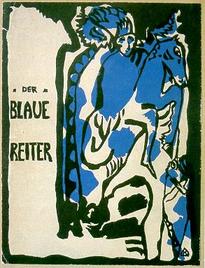
Der Blaue Reiter was a group of artists and a designation by Wassily Kandinsky and Franz Marc for their exhibition and publication activities, in which both artists acted as sole editors in the almanac of the same name. The editorial team organized two exhibitions in Munich in 1911 and 1912 to demonstrate their art-theoretical ideas based on the works of art exhibited. Traveling exhibitions in German and other European cities followed. The Blue Rider disbanded at the start of World War I in 1914.

August Robert Ludwig Macke was a German Expressionist painter. He was one of the leading members of the German Expressionist group Der Blaue Reiter. He lived during a particularly active time for German art: he saw the development of the main German Expressionist movements as well as the arrival of the successive avant-garde movements which were forming in the rest of Europe. As an artist of his time, Macke knew how to integrate into his painting the elements of the avant-garde which most interested him. Like his friend Franz Marc and Otto Soltau, he was one of the young German artists who died in the First World War.
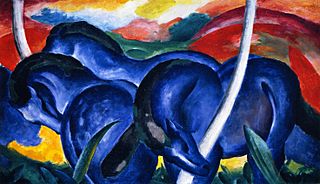
Blue Horses or Die grossen blauen Pferde is a 1911 painting by German painter and printmaker Franz Marc (1880–1916).
The year 1887 in art involved some significant events.
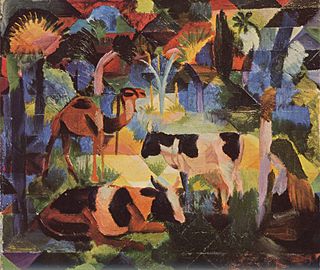
Landscape with Cows and Camel is a 1914 oil-on-canvas painting by German Expressionist painter August Macke. It is drawn in an expressionist style influenced by cubism and orphism. It is now housed at Kunsthaus Zürich.
Emmy Worringer (1878–1961) was a German artist and cofounder of the Gereonsklub, an avant-garde artists' association in Cologne in the years immediately preceding World War I.
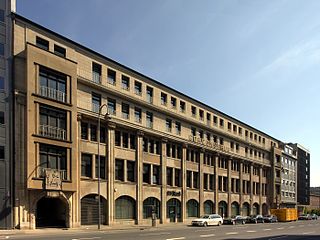
The Gereonsklub was an avant-garde artists' association in Cologne in the years immediately prior to World War I.

Bernhard Koehler was a German industrialist and art collector.

Two Women on the Hillside is an oil-on-canvas painting created in 1906 by German painter Franz Marc. It is part of the Bavarian State Painting Collections and is on a permanent loan at the Franz Marc Museum in Kochel am See.

Portrait with Apples, also known as Elisabeth with Apples, is an oil-on-canvas painting executed in 1909 by the German Expressionist painter August Macke. It shows his wife Elisabeth Gerhardt and was created shortly after their wedding. Macke had studied the work of the Fauve artists during his honeymoon in Paris, and the painting shows their influence. It marks the beginning of his public artistic appreciation. The work belongs to the collection of the Städtische Galerie im Lenbachhaus, in Munich.

Indians on Horseback is an oil-on-canvas painting executed in 1911 by the German Expressionist painter August Macke. It was created when the artist was under the influence of Cubism and had joined Der Blaue Reiter group through his friend Franz Marc. The painting belongs to the collection of the Städtische Galerie im Lenbachhaus, in Munich. It was donated by the Bernhard and Elly Koehler Foundation in 1965.

The Donkey Rider is a watercolor created in 1914 by the German Expressionist painter August Macke. It was created during the art-historically significant trip to Tunisia that he took with fellow painters Paul Klee and Louis Moilliet in April 1914. The watercolor is now in the collection of the August-Macke-Haus in Bonn.
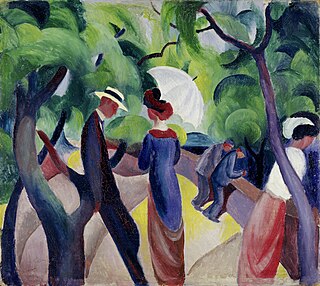
Promenade is an oil-on-cardboard painting by the German artist August Macke, executed in 1913. It is held at the Städtische Galerie im Lenbachhaus in Munich. Chronologically, it is the first of the paintings that he created after moving to Hilterfingen in Switzerland.

Woman with Umbrella in Front of a Hat Shop is an oil-on-canvas painting executed in 1914 by the German painter August Macke. It depicts a woman peeking into a hat shop, painted in an Expressionist style. The painting is in the collection of the Museum Folkwang in Essen.

Girls in Green, also known as Girls under Trees, is an oil-on-canvas painting by the German painter August Macke, executed in 1914. It depicts a number of girls among the trees on the edge of a lake, where the color areas of the figures and the environment seem to merge. The painting is in the collection of the Pinakothek der Moderne in Munich.

Fox, also known as Blue and Black Fox or Blue Fox, is an oil on canvas painting by Franz Marc, from 1911. It is part of the collection of the Von der Heydt Museum in Wuppertal.

Large Bright Showcase is an oil-on-canvas painting by the German artist August Macke, executed in 1912. It is held at the Sprengel Museum in Hanover.
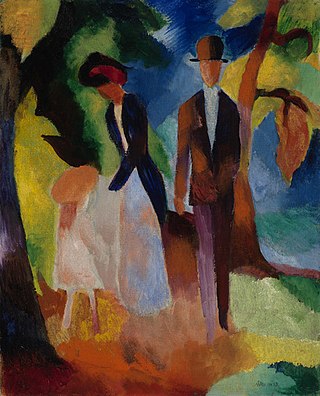
People on the Blue Lake is an oil-on-canvas painting executed in 1913 by the German artist August Macke. It is held in the Staatliche Kunsthalle Karlsruhe in Karlsruhe.

















